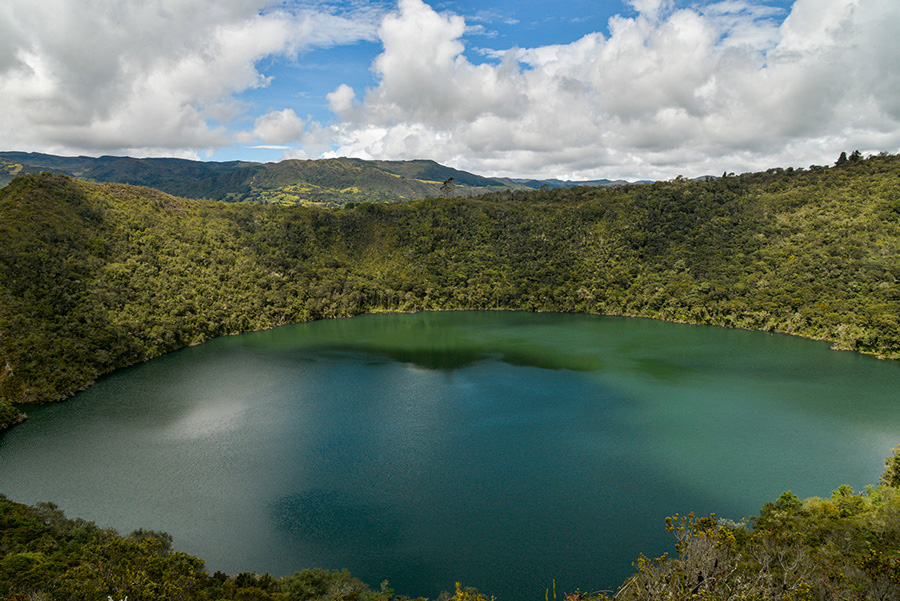
The traditional Muiscas stories inhabit in between mountains, lakes, and places full of a
special mysticism. El Dorado Legend Route involves sacred narrations, heroic tales, and
events that invite reflection and understanding. This journey is the best way to discover
more about Sue, Chía, Bachué, Bochica, Chiminigagua, Tundama, and more character
who speak of a past that nowadays is legend.
The genesis of all for the Muiscas laid on Chiminigagua, the supreme god, who
represented the birth of the Universe by union of cosmic energy. Chiminigagua sent two
birds hosting energy and light, who would provide the earth with shape. They were: The
Sun (Sue), the day; and The Moon (Chía), the night. When it was all done, Chiminigagua
commanded to honor The Sun and its wife The Moon. Adoring these stars, Muiscas
adored the Supreme Being.
The birth of man and the earth’s population is assigned to Bachué, Muisca people´s
mother. It is said she emerged from Lake Iguaque holding a boy in her arms. When the
boy became a man, they conceived children and that is how population grew. When the
earth was fully inhabited, they both (already elderly) came back to the Lake and turned into
a snake who submerged into the water until they disappeared.
The civilizing father of Muisca community was Bochica, who was not strictly a god, but a
pilgrim that brought in corn and potato (essential food still nowadays). This wiseman
taught the ancient settlers farming, gastronomy, astrology, meteorology, medicine, textile
work, goldsmithing, the use of salt and set up laws for peaceful interaction among towns.
He was Muiscas’ savior from the big flood (a kind of divine retribution) which almost swept
them out of existence. Powerful Bochica grabbed his cane and raised a dike, known today
as Salto del Tequendama, in order to drain Bacatá´s savannah and save Muiscas.
Another historical Muisca character was Tundama or Sayoso. He was Lord of Duitama
(Boyacá). This brave cacique lined up a legion of ten thousand men and went against
Spaniard’s dominance. While most of Muisca territory fell down sacked, he leaded the
resistance and in many occasions faced Spaniard troops; he also rejected truces and
reminded the extermination of Muisca Zipas and Zaques. Even though he stood tall, the
Spaniard cavalry was superior and took Duitama. He was cruelly murdered after being
caught as prisoner.
Many stories intertwine around Muisca universe and El Dorado Legend Route is your
chance to live them. Come to discover!
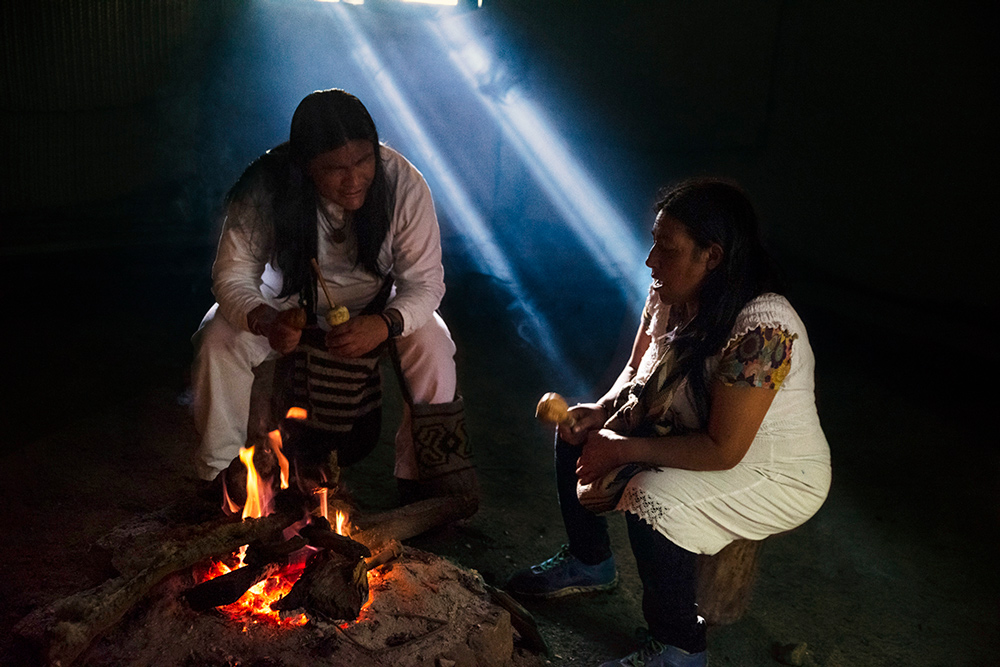
Along El Dorado Legend Route, the very first contact with the Muisca universe is provided
by its own protagonists: indigenous communities. The Muiscas built a unique and fully
sensitive relationship with nature:
“They worshiped and respected nature: water sources, stones, mountains,trees, and
lagoons (considered as places to purify, reflect, pray and as offering altars). Within the
cosmic order they honored the sun and the moon, the rainbow and the lightning, just as in
the terrestrial order alongside the elements and Gaia with her four codes (animal, vegetal,
mineral, and human)"
Mariana Escribano (Researcher and Literature, History and Semiology PhD).
Muiscas life pondered around the gods, ancestors and, of course, the land. The offerings
and oblations were fundamental ceremonial aspects, in which they sought keeping
universal balance. It is probable that Muiscas conferred a special sense to the facts of
walking, going step by step and searching a way as an outline of life. Therefore, rituals or
ceremonies like “Correr la tierra” were means for self-finding, expressing gratitude to the
gods and presenting worldly success.
This ritual´s dynamic consisted on an indigenous walk around five different worshiping
spots located far way one from the other. The first one was Lake Guatavita where the
formerly caciques were crowned. It continued with Lake Guasca or Martos which was
sacked to disappearance. Then, the third one was Lake Siecha, nearby Bogota, whose
tour was done by Bacatá cacique and his personal guard. At fourth, Lake Teusacá, that
had treasures (golden caimans, santillos and jewelry). Finally, their last venerating place
was Lake Ubaque or Carriega, known for taking so many greedy lives away.
The night before “Correr la tierra” chicha or facua (sacred drink made of corn) used to be
drunk. Along the tour, that could actually last up to 20 days, burials and competitions were
done to first reach the highest venerated summits. It was such an effort and hardness that
a lot of indigenous died in the way, either drowned, fatigued or fallen out way down the
cliffs.
After the competition, the deceased were honored like heroes. During the latest days, the
caciques gathered together to burn the turpentine day and night. The practice ended up
with an offering: decorated rafts full of gold, and in the middle of music and fire, they
headed towards Lake Guatavita´s core, where such items were totally sunk.
Another outstanding aspect from Muisca community was their ability to craft precious
metals and ceramic, weave cotton blankets with singular prints, and be cognizant of
ancestral medicine. The ancient settlers were expert traders, they exploited the salt (as
scared and traded element) whose main use was to exchange goods and services.
Some practices, customs, ceremonies and healings come to life today along the territory
inhabited by indigenous ancestors centuries ago. The Muisca legacy as warm and
peaceful people who cultivated mind and soul still remains and stays alive among their
sacred places such as Guatavita, Iguaque, Fúquene, Tota y Sogamoso. El Dorado Legend
Route is your chance to connect with Colombia´s heart and the origins of what we are.
Unmissable!

Muisca ceremonies and rituals were carried out in places full of unique features. In these
spaces they performed offerings to gods, caciques or community members were buried,
and the new cognizant and priests were instructed.
El Dorado Legend Route incorporates places that keep a deep symbolic and geographical
connection with ancient ceremonies and rituals. Based on the sky, sun, moon, and starts
observation, Muiscas predicted and determined the best times to do offerings, oblations,
sowings and harvests.
Likewise, they conferred places a meaning that nowadays represent the Muisca sense like
the Cusmuy: circular ceremonial structures built with guaiacum and straw-covered which
“are the body as a reflection of the world and territory where each element meets a
purpose. The same way, it is home; it is the school, where around the fire we listen to the
words shared in our hearts. It is the place where we form ourselves like people that take
care and prolong the masterpiece” (Plan de vida, Comunidad de Sesquilé)
Centuries ago, Muisca organization happened in “cercados”. Places of social encounters
surrounded by two or three fences, where the Cacique´s main house was located, and had
rooms for wives, warriors or priests and supplies warehouses. The “cercados” represented
protection and were sacred places full of an important spiritual and ceremonial energy.
Besides, El Dorado Legend Route covers mistic places like “Los Cojínes del Zaque”,
which is a complex center of solar worshipping settled down on a slope in Tunja (Boyacá).
This place has a strategic astronomic disposition. It was a ceremonial center and operated
like observatory and sacrifices altar. In the heart of it, two aligned mounds stand out
eastwards (just where the sun raises) that were actually carved with the same rock that
pops up from the hill. Muisca´s structures are still enigmatic for experts and visitors.
Some ceremonies keep being a mystery for scholars of Muisca culture; however, it is clear
there was an element loaded of particular symbolic value: Gold. To Muiscas, more than a
material, the gold had a spiritual distinction; many items (tunjos, ajuares, santillos and
others) were made to be offered in specific rituals and ceremony centers.
El Dorado Legend route includes the symbolic and spiritual gold sense and some other
elements in places such as: The Sun Temple, Lakes Iguaque and Tota in Boyacá; Lakes
Guatavita, Siecha, Fúquene y Ubaté in Cundinamarca; Mountains of Tensacá
(Monserrate) Chiguachía (Guadalupe); Gold Museum and Archeological Museum in
Bogotá.

Up on the sky, the stars keep ancestral secrets. El Dorado Legend Route encloses
astronomical observatories that have remained in time to realize of Sue (The Sun), Chía
(The Moon), the stars and all those elements from Heaven in Earth.
The stars observation allowed Muiscas to establish cycles for sowing and harvest, forecast
the weather, socially organize and explain the life itself. Muisca culture edified temples and
homes aligned with sunset, dusk and some planets like Venus.
Time and space were set through calendars that provided a cosmic order to each moment
in life. The ancient Muiscas counted the days like suns and months like moons; each
month (30 days) was divided in 3 parts of 10 days each. The initial 10 days, men isolated
from their women and chewed hayo (coca leave and salts). The second part of the month
was dedicated to farm and work; and the last stage was destined to their women´s
companion.
Today, just like back in the days, Muisca year begins on March 21 st during the equinox (a
natural phenomenon that makes every part of the world receive the same amount of light
and darkness. Thus, day and night have the same duration) Before each year begins, the
community collects products, a cleaning with ancestral medicine (sometimes Yagé) and
perform initiation rituals with community leaders in Lake Guatavita. One day before the
new year (March 20 th ) they celebrate a party to honor, and, when the year starts, they sow
seeds in the land.
El Dorado Legend Route is the opportunity to get into ancestral knowledge, learn about
the stars and their millenary sense. It is a once-in-a-lifetime chance to comprehend the
sense of life through a non-compared connection with nature. Your legendary journey
starts right here!
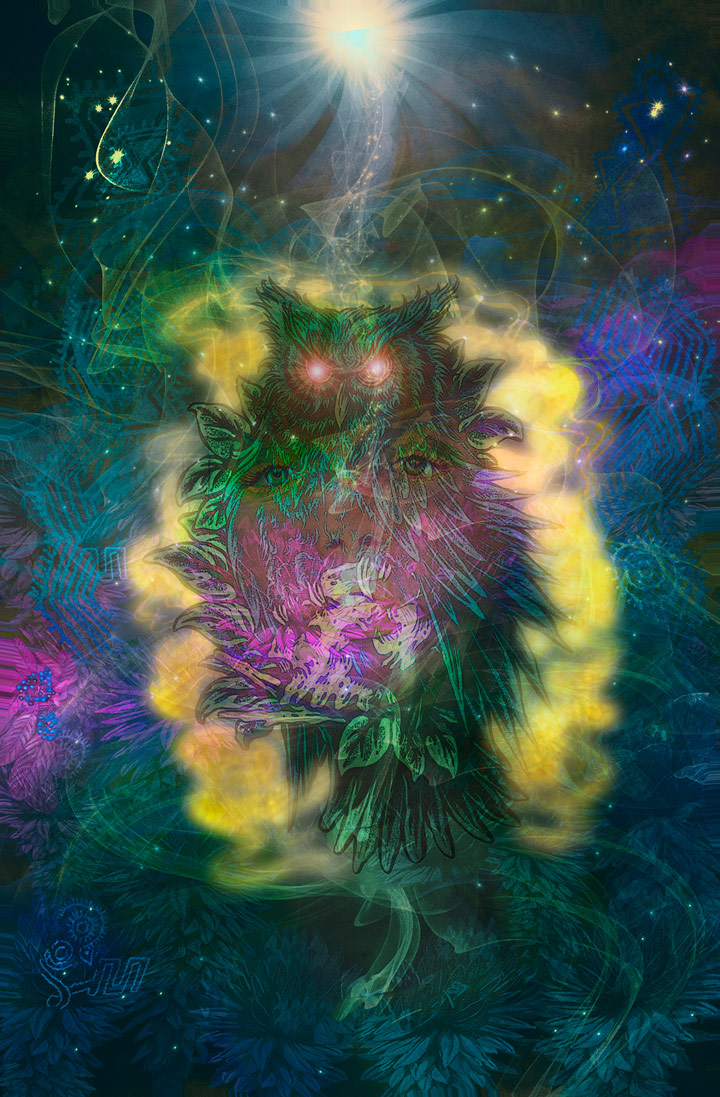
Goddess of pleasure, associated with gambling and entertainment. She was punished for corrupting the Muiscas and condemned to be an owl that accompanies Chia (the Moon) leaving only at night. For the Muiscas, it transmitted wisdom through the Tijiqui ritual (Borrachero or Floripondio), a sacred plant considered as a conductor of the spirit and the mind towards a progression that opens the doors to states of cosmic consciousness.
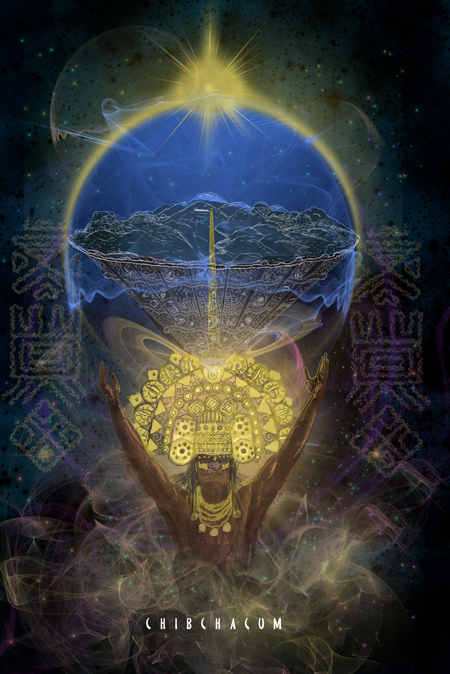
God of farming, patron saint of farmers, protector of corn and potatoes. He was the one who caused the closing of the Bacatá plateau that produced the great flood released by Bochica. The condemnation for Chibchacun was to carry on his shoulders the earth, which was previously supported on a large Guayacán; due to the weight Chibchacun must change position and for this reason the earth trembles. It resembles the figure of Atlas (Greek divinity) a giant who carries the earth on his shoulders.
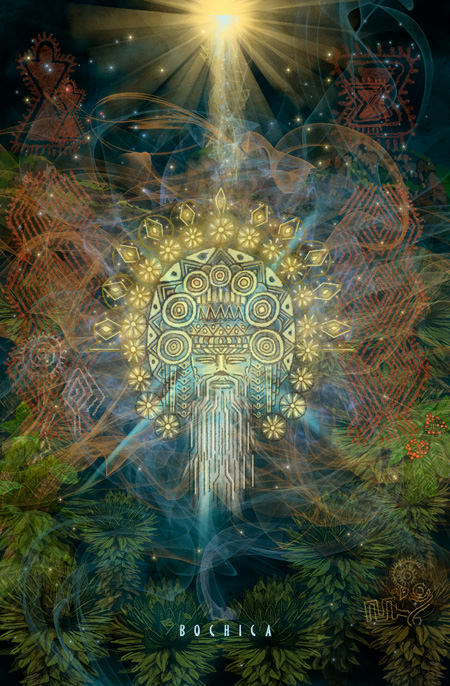
Civilizing father and instructor of the Muisca people. He was considered three times wise, great and powerful. He can travel through the seven dimensions of the abos (cosmos). He taught gastronomy, astrology, meteorology, medicine, alchemy, textile work, goldsmithing, use of salt, cultivation of the land (especially corn), imparted laws and promoted a peaceful coexistence with other peoples. He established the solar order of fire (Boyacá) and the lunar order of water (Bogotá). He was the savior of the Muisca people in the great flood, opening a dam in the Salto del Tequendama to drain the Bacatá altiplano.
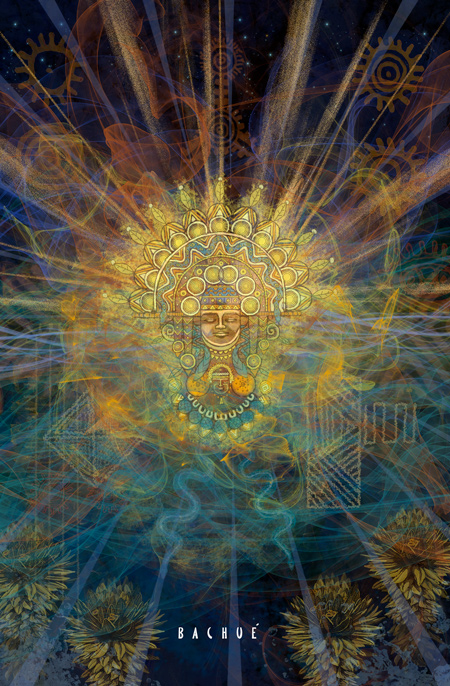
Goddess of life, white goddess, mother of the Muisca people. She is the product of the separation of the cosmic waters (Xia: water goddess-dual divinity; Tsia: waters of the sea; Sia: terrestrial waters, rains, lagoons and rivers). She emerged from the Iguaque lagoon with a child in her arms. When that child became a man, they conceived children (between 4 and 6 children would be born in each birth) and, in this way, the earth would be populated . When the earth was completely inhabited, both (elders) returned to the Iguaque lagoon, took the form of giant snakes and submerged in its waters until they disappeared. .
